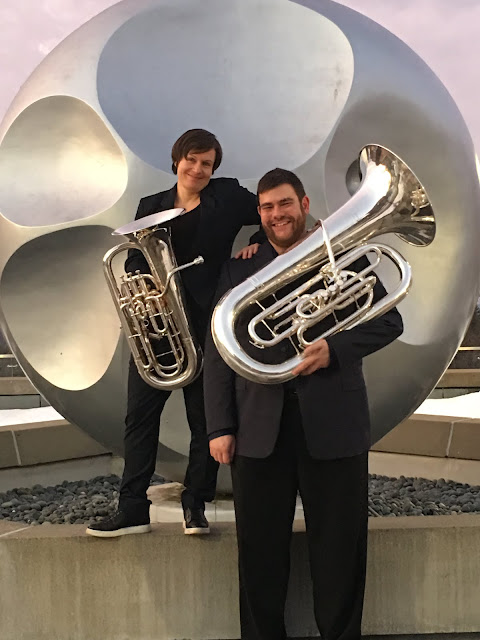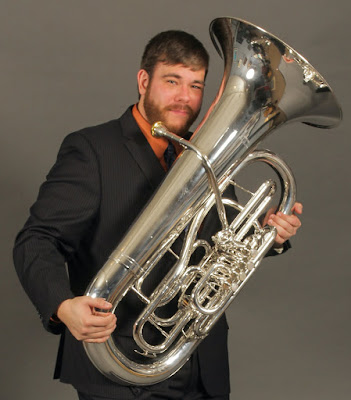David Earll
- What instruments do you use?
I play on the Willson 3050 FA-5 CC Tuba, Willson 3200 FA-5 XL F Tuba, and the Besson BE1065 Euphonium.
-
What manufacturer and model are the mouthpieces you use:
-
When and where did your studies on tuba euphonium start?
-
At what age?
-
What reasons or circumstances led you to study this instrument?
-
Who were your main teachers?
Please leave us a little account of his experience as a soloist, a member of chamber ensembles, orchestra, band, etc.
-
In Orchestra and / or Band:
I presently perform as the Acting Principal Tuba with the Cayuga Chamber Orchestra, which is based here in Ithaca, New York and I also serve as a substitute tubist with Symphoria, a larger symphony orchestra based in Syracuse, New York.
Before moving to New York from Wisconsin, I served as the first-call substitute tubist with the Dubuque Symphony Orchestra for 5 years – some of my favorite times with them included their outreach and educational concerts for children and students. During this time, I was also a member of the Tallgrass Brass Band and played CC tuba in their contrabass tuba section.
While I lived in Arizona I had the pleasure of performing in the tuba section with the Tempe Symphonic Wind Ensemble, and with the Salt River Brass Band (in both the bass tuba and contrabass tuba sections on F and CC tuba).
-
Metal & Chamber Ensembles:
I also collaborated with Dr. Samantha Keehn, an excellent trombonist who teaches Trombone, Euphonium, and Tuba at Augustana College in Rock Island, Illinois in a duo called Sam & Dave’s Brass Extravaganza. This duo toured regularly throughout the United States and had one extended tour in Germany featuring music for trombone, tuba, and multimedia (including electronic sounds, video, and images).
-
Solo concerts:
Generally speaking, I try to perform 2 or more solo tours in the United States and 1 international solo or chamber music tour each year. I’ve been very lucky to perform as a soloist throughout the United States (with most of my appearances in the Midwest, South, Southwest, Southeast, and Northeast.
I absolutely love traveling to perform, to make new amazing friends in the tuba/euphonium community, and to learn about the amazing traditions of performance and pedagogy with each new place that I visit.
In the upcoming years, my aim is to perform more often as a soloist with wind bands and orchestras.
-
Which uses warm-up exercises?
-
Could you give us your opinion on this and how would address this issue in the interests of education and training adapted to the necessary expertise required today?
- Tell us what learning centers you have taught (full-time professor, visiting professor, courses, lectures, etc.)
- How do you organize your classes and the subject in general?
- How long are your classes?
- Do you think it is important that students make public appearances during his years of training? If so, recommend how many times it deems appropriate and what age or course. Elementary, vocational, higher?
- Is there another teacher with your same specialty in the center where you teach?
- In your opinion, how should this problem be addressed? How important do you think is include learning and mastery of the orchestral repertoire as part of the curriculum of the course?
- Tell us what is the admission process to access your learning center:
This audition is 10 minutes for students applying for their Bachelor’s Degree and 20 minutes for students applying for their Master’s Degree which includes solo literature, orchestral/band excerpts, etudes, and scales. In addition to this audition, students also take a placement exam for music theory/aural skills.
Depending on which degree program a student is interested in (like: Music Education, Sound Recording Technology, Composition, etc) they will also have an interview with the area to which they are applying.
- What it is required repertoire in the entrance exam?
- Do you suggest any particular repertoire?
- How many works are required and in what format (solo, with piano, studies, etc.)?
- Is there a mandatory piece? If so, what is it?
- Approximately how long is the exam?
- What aspects you value most in deciding? ¿Musicality, intonation, rhythm, …?
- If I had to choose (in a hypothetical situation), would preferably between student Tuba Euphonium or one?
- What kind of repertoire you work primarily with your students? Solo, with piano accompaniment, chamber music, ….?
 |
| «The Northern Lights Duo» with Bente Illevold. |
- What format is examining LIMIT? Solo concert, piano recital …?
- Does the student selects the works to play? or they are chosen by the teacher?
- Is there any work it deems mandatory? If so, what?
- Could you give us your opinion about different concepts of sound and what characteristics define, articulation, types of instruments, literature, if the influence of language and musical tradition in sound and way of playing is considered important ?
I love to hear the differences in sound concepts as I travel, and think that each of these contributes another very important facet to the diversity and international variety of tuba playing. In my teaching, I spend quite a bit of time working with the different regional dialects of American English to help students gain a better understanding of their tongues and how to control their sounds.
-
Tell us a bit about the manufacture of Tubas and / or Euphoniums and mouthpieces and tell us about your experiences and tastes of a particular manufacturer and why?
- Tell us about your experiences and tastes of a particular manufacturer and why?
| «From a Willson Exhibition with Polar Brass in Oslo, Norway.» |
- In your experience, do you think the diversity of performers, instruments and the opportunity to train in various specialized schools is homogenizing in interpretive centers already established? (Example: Russian, American, German-Austrian, English, etc.).

